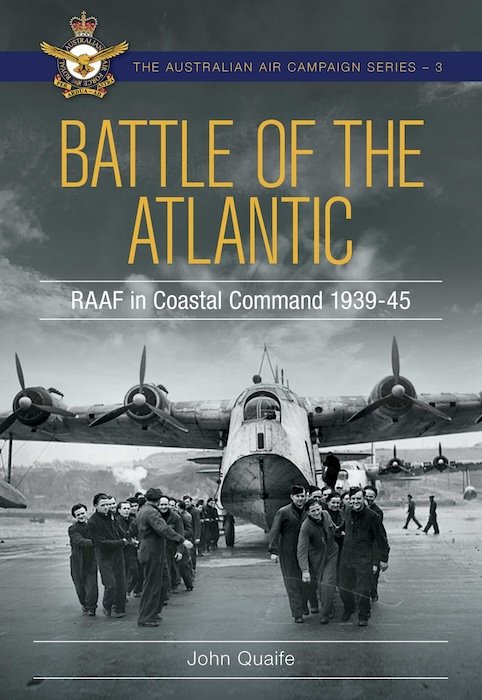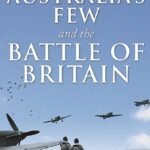
For the last (?) time: all RAAF, all the time; from Bristol Fighters through Sunderlands and Sabres to Super Hornets.
Lewis Frederickson, Armageddon and OKRA: Australia’s Air Operations in the Middle East a Century Apart (Newport: Big Sky Publishing, 2020).
Mark Lax, Malayan Emergency and Indonesian Confrontation: 1950 to 1966 (Newport: Big Sky Publishing, 2021).
John Quaife, Battle of the Atlantic: RAAF in Coastal Command 1939-45 (Newport: Big Sky Publishing, 2022).
It was a very welcome development when RAAF History and Heritage,((‘History and Heritage Branch – Air Force’, to be formal.)) in conjunction with Big Sky Publishing, began publishing a series of accessible and affordable books on various aspects of Australian airpower history. Of course, I’ve bought most of them; of course, I hadn’t read any of them. I was hoping to remedy that with this series, but relying on a random number generator to choose the books I’ve been reading meant that none of them came up. So for the last post this year, I decided to override blind chance and just read nos. 1-3 in the series.
All three are very attractively produced books: heavily, glossily illustrated and with numerous panels expanding on various topics such as combined air operations centres, No. 2 Airfield Construction Squadron or the Ju 88. But while each of these books are clearly well-researched (and Frederickson and Lax have history PhDs), they are not academic monographs. So while there are reasonably full bibliographies and some footnotes, there are sometimes omissions where I (for one) would like more detail, and there’s not much engagement with the historiography.((Given that the literature on these topics is not exactly massive, I’m surprised not to see the likes of Michael Molkentin, Matthew Radcliffe, or Christina Goulter cited, though to be fair in the latter case Quaife’s focus in on anti-submarine, not anti-shipping, warfare.)) And that’s to be expected, given the brief. That said, Lax does outline some of the arguments about the effectiveness of the bombing of Communist insurgents (or rather the jungle where they were camped) during the Malayan campaign, while Frederickson shows himself to be fully aware of the politically controversial nature of Australian military involvement in the Middle East. So these are not merely reassuringly cozy histories, though, to be fair, nor are they likely to cause anyone any embarrassment.((Frederickson is a serving RAAF officer as well as CAS Fellow at ADFA; Lax is a retired air commodore and Quaife a retired air vice marshal.)
The periods covered by these three volumes is wide, spanning the First World War, the Second World War, the Cold War, and the present – a timeline in Armageddon and OKRA, published in 2020, carries right on up to December 2017. Armageddon and OKRA here is definitely the most chronologically ambitious, as it is split into two halves on very different eras. One half is nominally about No. 1 Squadron AFC’s signal role in the destruction of the Turkish Seventh Army at the Battle of Armageddon (or Meggido, as it is more usually termed) on 21 September 1918, though along the way Frederickson covers most aspects of the AFC’s operations in the Middle East from 1915 to 1918. The other half is about the air aspects of Operation Okra, the ADF’s contribution to the coalition war against Islamic State beginning in 2014, which saw the RAAF’s most sustained fighting since the Vietnam War (including No. 1 Squadron once more). So these are certainly very worthy topics. I’m not convinced they fully work together in the one book since, apart from the rough coincidence of location, the eras are just so technologically, logistically and administratively different that they have little in common which each other. (Though Frederickson does isolate airpower ‘lessons’ throughout the book.) But then in that sense Armageddon and OKRA does work as a demonstration of how much airpower has changed in application and effect over nearly a century.
Lax’s Malayan Emergency and Indonesian Confrontation is probably the most comprehensive of the three. Not only is it the longest, but as well as a thorough account of the aviation aspects of the British anti-communist operation in Malaya (including transport, reconnaissance, and propaganda — ‘sky shouting’ via loudspeaker for which RAAF Dakotas were used, though without RAAF aircrew), Lax also clearly sets the RAAF contribution (Australian Lincolns dropped 85 per cent of the bomb tonnage; RAAF officers held senior commands over Commonwealth air forces) into the wider context of the RAF presence in south-east Asia, as well as provides a thorough explanation of the evolving British strategy. The final chapter looks at the Indonesian attempt to undermine newly independent Malaysia through border incursions. The action here mainly involved ground forces, but the possibility of needing to intercept MiG-19s and Tu-16s, launching retaliatory strikes against air bases in Indonesia, as well as for that matter the outside chance of having to defend Darwin from attack, made planning in the Confrontation a lot more complicated than in the Emergency. All of which Malayan Emergency and Indonesian Confrontation conveys very clearly.
By contrast, Quaife’s Battle of the Atlantic is the slenderest, and arguably the narrowest in scope (though the significance of the Battle is fully explained), but it’s probably the one I enjoyed reading the most. Partly that’s because Sunderlands, but also because I wanted to learn more about No. 10 Squadron, which just happened to be in Britain to take said Sunderlands back to Australia when war broke up, and ended up staying the whole war as part of Coastal Command. That made it unique, as it was remained an actually Australian squadron, with more or less completely Australian air and ground crew, rather than a nominally Australian one as with the Article XV squadrons (though Quaife’s other focus is No. 461 Squadron, which was spun out of No. 10 Squadron but under Article XV). I still would like to know more about how this worked administratively, on the other side of the world while there was a war on, but that might just be me. Still, with all the Sunderland action around the Bay of Biscay and beyond, there’s enough here to whet my appetite.
This is the end of my year of reading airmindedly, which as well as intending to celebrate 240 years since the Montgolfiers and 120 years since the Wrights, was meant to cut down my alarmingly tall pile of unread aviation history books. So how did I go? Well, I did better on the Montgolfiers than the Wrights (one book vs none). More importantly, as a little arithmetic shows, I read 48 aviation history books for this series, which I think is pretty decent; and as I’ve got about 35 left in the list that means I cut down the TBR pile by over half, which again I’m very happy with. I liked the random factor, as it made me read things I might not otherwise have consciously picked up. And even if it’s a little postgraduate, I even enjoyed the process of publicly reflecting on each book’s merits, which also had the happy effect of generating content for the blog. So I plan to keep going with this series next year in some form, though at a reduced frequency, maybe once every two or three months. And since my pile of unread First World War aviation history books is now getting alarmingly tall, I might start there…
![]() This work is licensed under a Creative Commons Attribution-NonCommercial-NoDerivatives 4.0 International License.
Permissions beyond the scope of this license may be available at http://airminded.org/copyright/.
This work is licensed under a Creative Commons Attribution-NonCommercial-NoDerivatives 4.0 International License.
Permissions beyond the scope of this license may be available at http://airminded.org/copyright/.




Thanks for the reviews Brett. RAAF H&H are working on a companion manuscript focussed on 455 SQN and the anti-shipping campaign under the title ANZAC Strike Wing. To be released this year hopefully.
Cheers,
John Quaife
You’re welcome John! I look forward to the follow-up.